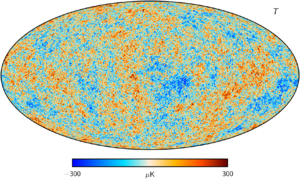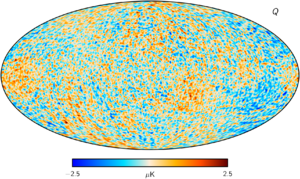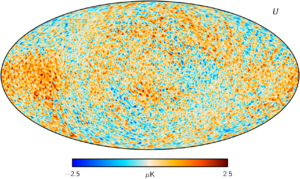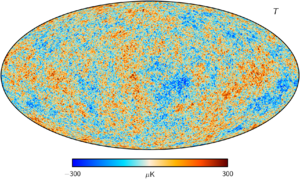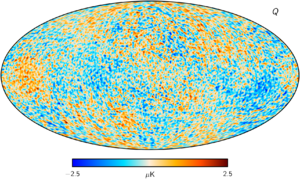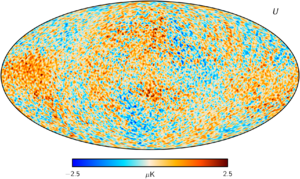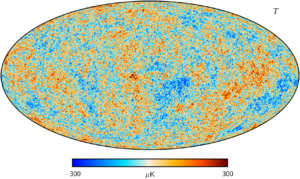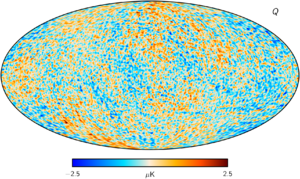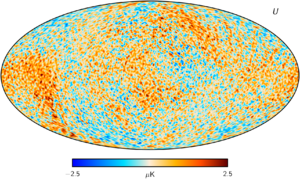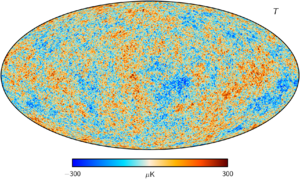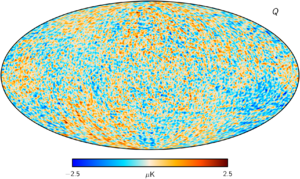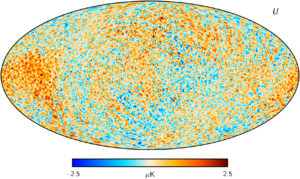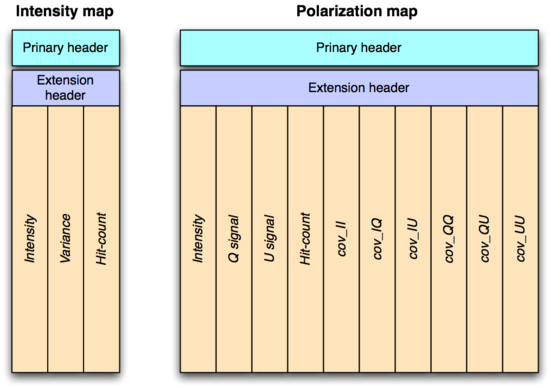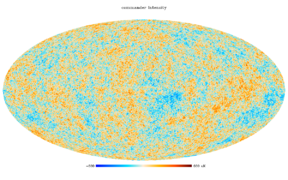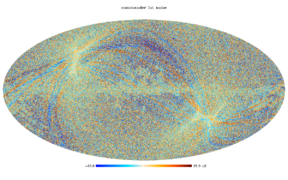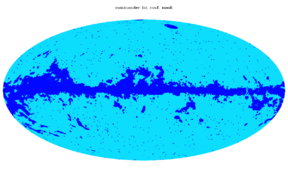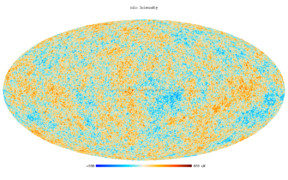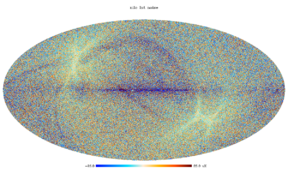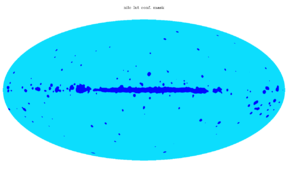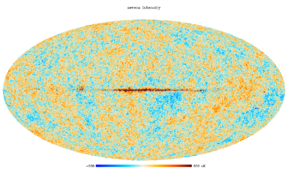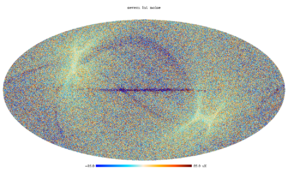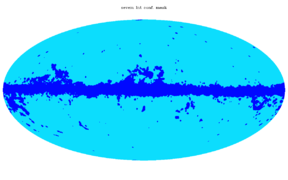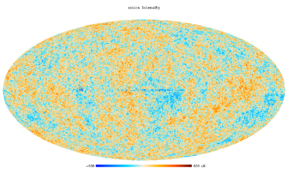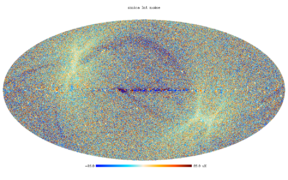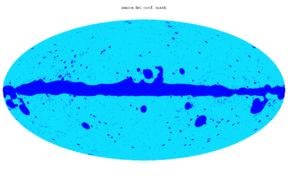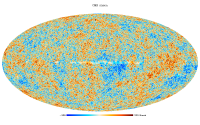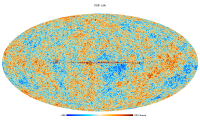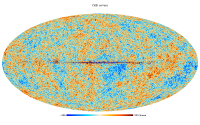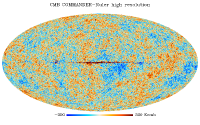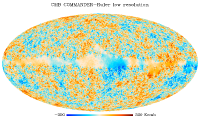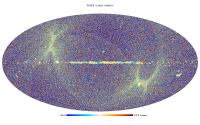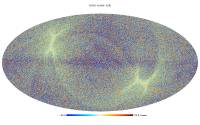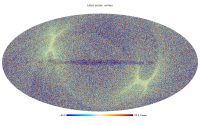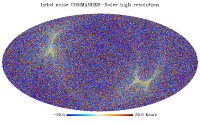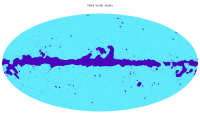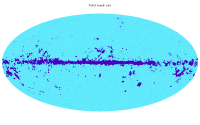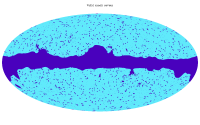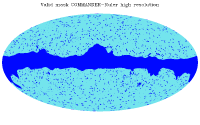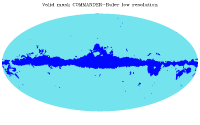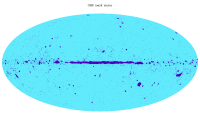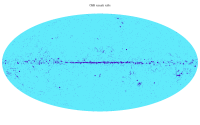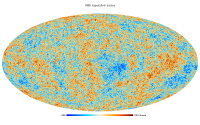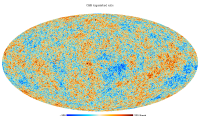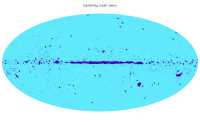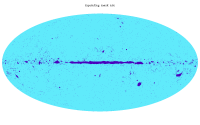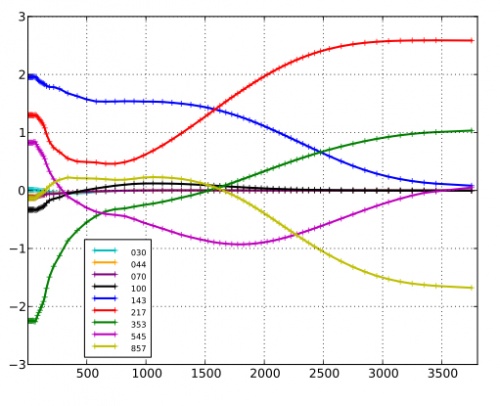2018 CMB maps
Contents
[hide]Overview[edit]
This section describes the CMB maps produced from the Planck data. These products are derived from some or all of the nine frequency channel maps using different techniques and, in some cases, using other constraints from external data sets. Here we give a brief description of each product and how it is obtained, followed by a description of the FITS file containing the data and associated information. All the details can be found in Planck-2020-A4[1] and, for earlier releases, in Planck-2013-XII[2] and Planck-2015-A09[3].
2018 CMB maps[edit]
CMB maps have been produced using four different methods: COMMANDER, NILC, SEVEM, and SMICA, as described in the CMB and foreground separation section and also in Appendices A-D of Planck-2020-A4[1] and references therein.
For each method we provide the following:
- Full-mission CMB intensity map, with corresponding confidence mask and effective beam transfer function.
- Full-mission CMB polarisation map, with corresponding confidence mask and effective beam transfer function.
- In-painted CMB intensity and polarisation maps, intended for PR purposes.
In addition, and for characterisation purposes, we include four other sets of maps from two data splits: odd/even ring and first/second half-mission. Half-difference maps can be used to provide an approximate noise estimates for the full mission, but they should be used with caution. Each split has caveats in this regard: there are noise correlations between the odd/even split maps, and unobserved pixels in both splits. Masks flagging unobserved pixels are provided for each split, and we strongly encourage use of these when analysing split maps.
In addition, for SMICA, we also provide a CMB map from which Sunyaev-Zeldovich (SZ) sources have been projected out, while SEVEM provides cleaned single-frequency maps at 70, 100, 143 and 217 GHz for both intensity and polarization.
All CMB products are provided at an approximate angular resolution of 5 arcmin FWHM, and HEALPix resolution Nside=2048. Explicit effective beam profiles are provided for each foreground reduced CMB map.
For a complete description of the above data structures, see below; the content of the first extensions is illustrated and commented in the table below.
The gallery below shows the inpainted full-mission CMB maps (T, Q and U) from each pipeline. The temperature maps are shown at 5 arcmin FWHM resolution, while the polarization maps are shown at 80 arcmin FWHM resolution, in order to suppress instrumental noise.
Product description[edit]
COMMANDER[edit]
- Principle
- COMMANDER is a Planck software code implementing Bayesian parametric component separation. Each astrophysical signal component is modelled in terms of a small number of free parameters per pixel, typically in terms of an amplitude at a given reference frequency and a small set of spectral parameters, and these are fitted to the data with an MCMC Gibbs sampling algorithm. A new feature in the Planck 2018 analysis is support for multi-resolution analysis, allowing reconstruction of both CMB and foreground maps at full angular resolution. Only CMB products are provided from Commander in the Planck 2018 release (see Planck-2020-A4[1] for details), while for polarization both CMB and foreground products are provided. For temperature, a dedicated low-resolution CMB map is also provided as part of the Planck likelihood package.
- Resolution (effective beam)
- The Commander sky maps have different angular resolutions depending on data products:
- CMB temperature and polarization and thermal dust polarization maps are provided at 5 arcmin FWHM resolution
- Synchrotron polarization maps are provided at 40 arcmin FWHM resolution
- The low-resolution CMB likelihood map is provided at an angular resolution of 40 arcmin FWHM.
- Confidence mask
- The Commander temperature confidence mask is produced by thresholding the chi-square map characterizing the global fits, combined with direct CO amplitude thresholding to eliminate known leakage effects. In addition, we exclude all pixels brighter than 10mK in the 30GHz map, in order to remove particularly bright radio sources. Finally, we remove by hand the Virgo and Coma clusters, as well as the Crab nebula. A total of 88% of the sky is admitted for analysis.
- The Commander polarization mask is produced in a similar manner, starting by thresholding the chi-squared map. In addition, we exclude all pixels for which the thermal dust polarization amplitude is brighter than 20µKRJ at 353GHz, as well as particularly bright objects in the PCCS2 source catalog. Finally, we remove a small region that is particularly contaminated by cosmic ray glitches. A total of 86% of the sky is admitted for analysis.
- Pre-processing and data selection
- The primary Commander 2018 analysis is carried out at full angular resolution, and no smoothing to a common resolution is applied to the maps, in constrast to the procedure employed in previous releases. The temperature analysis employs all nine Planck frequency maps between 30 and 857 GHz, while the polarization analysis employs the seven frequency maps between 30 and 353 GHz. No external data are used in the 2018 Commander analysis.
- Priors
- The following priors are enforced in the Commander analysis:
- The 30 GHz zero-level is fixed to zero, while the 44 and 70 GHz zero-levels are fitted freely with uniform priors. HFI zero-levels are fitted with a strong CIB prior.
- Dipoles are fitted only at 70 and 100 GHz; all other are fixed to zero.
- Gaussian priors are enforced on spectral parameters, with values informed by the values derived in the high signal-to-noise areas of the sky
- The Jeffreys ignorance prior is enforced on spectral parameters in addition to the informative Gaussian priors
- Fitting procedure
- Given data and priors, Commander either maximizes, or samples from, the Bayesian posterior, P(theta|data). Because this is a highly non-Gaussian and correlated distribution, involving millions of parameters, these operations are performed by means of the Gibbs sampling algorithm, in which joint samples from the full distributions are generated by iteratively sampling from the corresponding conditional posterior distributions, P(theta_i| data, theta_{j/=i}). All parameters are optimized jointly.
NILC[edit]
- Principle
- Needlet Internal Linear Combination (or NILC in short) is a blind component separation method for the measurement of Cosmic Microwave Background (CMB) from the multi-frequency observations of sky. It is an implementation of an Internal Linear Combination (ILC) of the frequency channels under consideration with minimum error variance on a frame of spherical wavelets called needlets, allowing localized filtering in both pixel space and harmonic space. The method includes multipoles up to 4000. Temperature and, E-mode and B-mode of polarization maps are produced independently. The Q and U maps of CMB polarization have been reconstructed from the corresponding E-mode and B-mode maps.
- Resolution (effective beam)
- The effective beam is equivalent to a Gaussian circular beam with FWHM=5 arcminutes.
- Confidence mask
- For each needlet scale, we identify the frequency channel that contributes the most to the final reconstruction of CMB for that band. Then we scale the sky maps for 30GHz and 353GHz to that frequency channel to obtain the scaled-sky map and compute the root mean square (RMS) of full mission CMB map. The mask is obtained by setting a cut-off at each needlet scale. The cutoff values are 500 times the RMS value of CMB for temperature and 1500 times the RMS value of CMB for polarization for each scale. The final mask is reconstructed from the union of all the masks obtained at different needlet scales. The confidence masks cover the most contaminated regions of the sky, leaving approximately 78.6 per cent of useful sky for temperature and 82 per cent for polarization.
- Pre-processing
- All sky maps are convolved/deconvolved in harmonic space, to a common beam resolution corresponding to a Gaussian beam of 5 arc-minutes FWHM. A very small preprocessing mask has been used on the temperature sky maps. Prior to implement the pipeline on the sky maps, the masked regions are filled using PSM tools which uses an increasing number of neighboring pixels to fill regions deeper in the hole. At each iteration it uses pixels at up to twice the diameter of the pixel times number of iteration. No preprocessing has been done on polarization sky maps.
- Linear combination
- Needlet ILC weights are computed for each of T, E and B, for each scale and for each pixel of the needlet representation at that scale. For each of T, E and B, a full-sky CMB map, at 5 arc-minutes beam resolution, is synthesized from the NILC needlet coefficients.
- Post-processing
- E and B maps are re-combined into Q and U products using standard HEALPix tools.
SEVEM[edit]
- Principle
- SEVEM produces cleaned CMB maps at several frequencies by using a procedure based on template fitting in real space. The templates used in the SEVEM pipeline are typically constructed by subtracting two close Planck frequency channel maps, after first smoothing them to a common resolution to ensure that the CMB signal is properly removed. A linear combination of the templates is then subtracted from (hitherto unused) map d to produce a cleaned CMB map at that frequency. This is done in real space at each position on the sky:
where is the number of templates. The coefficients are obtained by minimising the variance of the cleaned map outside a given mask. Note that the same expression applies for I, Q and U. Although we exclude very contaminated regions during the minimization, the subtraction is performed for all pixels and, therefore, the cleaned maps cover the full-sky (although foreground residuals are expected to be particularly large in those areas excluded by the minimisation). In the cleaning process, no assumptions about the foregrounds or noise levels are needed, rendering the technique very robust. A subset of the cleaned single frequency maps are then combined to obtain the final CMB map.
There are several possible configurations of SEVEM with regard to the number of frequency maps which are cleaned or the number of templates that are used in the fitting. Note that the production of cleaned maps at different frequencies is of great interest by itself in order to test the robustness of the results, and these intermediate products (cleaned maps at individual frequencies for intensity and polarization) are also provided in the archive. Therefore, to define the best strategy, one needs to find a compromise between the number of maps that can be cleaned and the number of templates that can be constructed.
- Intensity
For the CMB intensity case, we have cleaned the 70, 100, 143 and 217 GHz maps using a total of five templates. In particular, three templates constructed as the difference of two consecutive Planck channels smoothed to a common resolution [30GHz – 44GHz], [44GHz – 70GHz] and [543GHz – 535GHz] as well as a fourth template given by the 857 GHz channel are used to clean the 100, 143 and 217 GHz maps. Before constructing the templates, the six frequency channels involved in the templates are inpainted at the corresponding point source positions detected at each frequency using the Mexican Hat Wavelet algorithm (these positions are given in the provided point sources masks). The size of the holes to be inpainted is determined taking into account the beam size of the channel as well as the flux of each source. The inpainting algorithm is based on simple diffuse inpainting, which fills one pixel with the mean value of the neighbouring pixels in an iterative way. To avoid inconsistencies when subtracting two channels, each frequency map is inpainted on the sources detected in that map and on the second map (if any) used to construct the template. Then the maps are smoothed to a common resolution, by convolving the first map with the beam of the second one and viceversa. For the fourth template, we simply filter the inpainted 857 GHz map with the 545 GHz beam. The cleaned 70 GHz map is produced similarly by considering two templates, the [30GHz – 44GHz] map and a second template obtained as [353GHz – 143GHz] constructed at the original resolution of the 70 GHz map.
The coefficients to clean the frequency maps are obtained by minimising the variance outside the analysis mask, that covers the 1 per cent brightest emission of the sky as well as point sources detected at all frequency channels. Once the maps are cleaned, each of them is inpainted on the point sources positions detected at that (raw) channel. Then, the Mexican Hat Wavelet algorithm is run again, now on the cleaned maps. A number of new sources are found and are also inpainted at each channel. The resolution of the cleaned map is the same as that of the original data. Our final CMB map is then constructed by combining the 143 and 217 GHz maps by weighting the maps in harmonic space taking into account the noise level, the resolution and a rough estimation of the foreground residuals of each map (obtained from realistic simulations). This final map has a resolution corresponding to a Gaussian beam of fwhm=5 arcminutes and Nside=2048 and the maximum considered multipole is . The monopole and dipole over the full-sky have been subtracted from the final CMB map.
In addition, the cleaned CMB maps produced at 70, 100, 143 and 217 GHz frequencies are also provided. The resolution of these maps is the same as that of the uncleaned frequency channels and have been constructed at Nside=1024 for 70 GHz and Nside=2048 for the rest of the maps. They have been inpainted at the position of the point sources detected in the raw and cleaned maps (these positions are given in the corresponding inpainting masks). The monopole and dipole over the full-sky have also been removed from each of the cleaned maps.
The confidence mask is produced by studying the differences between several SEVEM CMB reconstructions, which correspond to maps cleaned at different frequencies or using different analysis masks. The obtained mask leaves a useful sky fraction of approximately 84 per cent.
- Polarization
To clean the polarization maps, a procedure similar to the one used for intensity data is applied to the Q and U maps independently. Cleaned maps at 70, 100, 143 and 217 GHz are also produced but, given that a smaller number of frequency channels is available for polarization, the templates selected to clean the maps are different. In particular, we clean the 70 GHz map using two templates and the rest of the channels using different combinations of three templates.
Following the same procedure as for the intensity case, those channels involved in the construction of the templates are inpainted in the position of the sources detected in the raw frequency maps. The sources are selected from a non-blind search, based on the Filtered Fusion technique, using as candidates those sources detected in intensity. These inpainted maps are then used to construct a total of six templates, one of them at two different resolutions. To trace the synchrotron emission, we construct a template as the subtraction of the 30 GHz minus the 44 GHz map, after being convolved with the beam of each other. For the dust emission, the following templates are considered: [217GHz – 143GHz], [217GHz – 100GHz] and [143GHz – 100GHz] at 1 degree resolution, [353GHz – 217GHz] and [353GHz – 143GHz] at 10 arcminutes resolution. The last template is also constructed at the resolution of the 70 GHz channel, in order to clean that map.
Different combinations of these templates (see Table C.3 in Planck-2020-A4[1] for details) are then used to clean the raw 70, 100, 143 and 217 GHz channels (at its native resolution). The corresponding linear coefficients are estimated independently for Q and U by minimising the variance of the cleaned maps outside a mask, that covers the point sources detected in polarization and the 3 per cent brightest Galactic emission. Once the maps have been cleaned, inpainting of the point sources detected at the corresponding raw maps is carried out. Then the non-blind search for point sources is run again on the cleaned maps and the new identified sources are also inpainted. The 100, 143 and 217 GHz cleaned maps are then combined in harmonic space, using E and B decomposition, to produce the final CMB maps for the Q and U components at a resolution of 5' (Gaussian beam) for a HEALPix parameter Nside=2048. The maximum considered multipole is . Each map is weighted taking into account its noise and resolution. In addition, the lowest multipoles of the 217 GHz cleaned map are down-weighting, since they are expected to be more contaminated by the presence of residual systematics.
The cleaned CMB maps at individual frequency channels produced as intermediate steps of SEVEM are also provided for Q and U, at their native resolution. The four pairs of Q/U maps have been inpainted in the positions of the detected point sources (given by the corresponding inpainting masks).
The confidence mask is constructed as the product of two different masks. One of them is obtained from the 353 GHz data channel and excludes those regions more contaminated by thermal dust. The second mask is constructed by thresholding a map of the ratio between the locally estimated RMS of P in the cleaned CMB map, over the same quantity expected for a map containg CMB plus noise. The combination of these two masks leaves a useful sky fraction of approximately 80 per cent.
- Resolution
- The cleaned CMB maps for intensity and polarization are constructed at Nside=2048 and at the standard resolution of 5 arcminutes (Gaussian beam). The maximum considered multipole is for intensity and for polarization.
- Confidence masks
- The confidence masks cover the most contaminated regions of the sky, leaving approximately 84 per cent of useful sky for intensity, and 80 per cent for polarization.
- Point source masks
- The point source masks contain the holes corresponding to the point sources detected at each raw Planck frequency channel in intensity and polarization. The number of sources detected are given in the upper part of Table C.1 of Planck-2020-A4[1]. There is one mask for intensity and another one for polarization per frequency channel. When using the Planck channels in the construction of the templates, these have been inpainted in the positions of the point sources given in these masks, to reduce the emission from this contaminant in the templates and its propagation to the final cleaned CMB maps.
- Inpainting masks
- The inpainting masks include the positions of the point sources that have been inpainted in the cleaned single-frequency maps. They contain point sources detected at the original raw data at those frequencies plus the sources detected in the cleaned frequency maps (see Table C.1 of Planck-2020-A4[1]). There is a mask for intensity and another one for polarization for each of the cleaned frequency maps (70, 100, 143 and 217 GHz) as well as the corresponding masks for the combined map. The latter are constructed as the product of the individual frequency masks of those cleaned channels that are combined in the final CMB map (i.e., the product of 143 and 217 GHz masks for intensity and of 100, 143 and 217 GHz for polarization). Note that the inpainted positions are not excluded by default by the SEVEM confidence mask, but only if they are considered unreliable with the general procedure used to construct the SEVEM confidence mask.
Foreground-subtracted maps[edit]
In addition to the regular CMB maps, SEVEM provides maps cleaned of the foregrounds for selected frequency channels (categorized as fgsub-sevem in the archive). In particular, for both intensity and polarization there are cleaned CMB maps available at 70, 100, 143 and 217 GHz, provided at the original resolution and Nside of the uncleaned channel (1024 for 70 GHz and 2048 for the rest of the maps).
SMICA[edit]
- Principle
- SMICA produces CMB maps by linearly combining Planck input channels with multipole-dependent weights, including multipoles up to . Temperature and polarization maps are produced independently. In temperature, two distinct CMB renderings are produced and then merged (hybridized) together into a single CMB intensity map. In polarization, the E and B modes are processed independently and the results are combined to produce Q and U maps.
- Resolution (effective beam)
- The SMICA intensity map has an effective beam window function of 5 arc-minutes which is truncated at .
- The SMICA Q and U maps are obtained similarly but are produced at =1024 with an effective beam of 10 arc-minutes.
- Confidence mask
- A confidence mask is provided which excludes some parts of the Galactic plane, some very bright areas and masked point sources. This mask provides a qualitative (and subjective) indication of the cleanliness of a pixel.
- Intensity.
SMICA operation starts with a pre-processing step to deal with regions of very strong emission (such as the Galactic center) and point sources. The nine pre-processed Planck frequency channels from 30 to 857 GHz are then masked and harmonically transformed up to to form spectral statistics (all auto- and cross- angular spectra). Two different masks are used to compute the spectral statistics. The first one preserves most of the sky while the second preserves CMB-dominated areas. These two sets of spectral statistics are used to determine two sets of harmonic weights which are thus adapted to two different levels of contamination. Two CMB intensity maps are produced and then merged into a single intensity product. The merging process is devised so that the information at high Galactic latitude and medium-to-high multipole is provided by the CMB map computed from high Galatic latitude statistics (note that this map does not include the LFI channels) while the remaining information is provided by the other CMB map (which does include all Planck channels). See Planck-2020-A4[1] for more details.
- Polarisation.
The SMICA pipeline for polarization uses all the 7 polarized Planck channels. The E and B modes of the frequency maps are processed independently by SMICA to produce E and B modes of the CMB map from which Q and U maps are derived. The foreground model fitted by SMICA is 6-dimensional which is the maximal dimension supported by SMICA when operating in blind mode, that is, assuming nothing about the foregrounds except that they can be represented by a superposition of 6 components with unconstrained emission laws, unconstrained angular spectra and unconstrained angular correlation. See Planck-2020-A4[1] for more details.
Note: in general, any I, Q and U CMB map can be transformed into a T, E and B CMB map using the HEALpix routines "anafast" and "synfast"(See the links below for the details). The "anafast" routine generates harmonic coefficients of T, E and B maps from the full sky I, Q and U maps. Finally, the full sky T, E and B maps in real space are generated using "synfast" routine separately from the corresponding harmonic coefficients obtained using "anafast". Further details about the spherical harmonic transform from HEALPix can be found in https://healpix.jpl.nasa.gov/html/intro.htm, https://healpix.jpl.nasa.gov/html/idlnode25.htm, and https://healpix.jpl.nasa.gov/html/idlnode27.htm". In the particular case of NILC, that works in needlet space, the IQU maps are converted into TEB maps using anafast and synfast, while in the case of SMICA, that works in harmonic space, the IQU maps are converted into TEB harmonic coefficents (alms) using anafast only.
Common Masks[edit]
Common masks have been defined for analysis of the CMB temperature and polarization maps. In previous releases, these were constructed simply as the union of the individual pipeline confidence masks. In the 2018 release, a more direct approach has been adopted, by thresholding the standard deviation map evaluated between each of the four cleaned CMB maps. This standard deviation mask is then augmented with the Commander and SEVEM confidence masks, as well as with the SEVEM and SMICA in-painting masks.
In addition, we provide masks for unobserved pixels for the half-mission and odd-even data splits, as well as an in-painting mask. The latter is not intended for scientific analysis, but for producing visually acceptable CMB representation for PR purposes.
In total, we provide the following masks:
- COM_Mask_CMB-common-Mask-Int_2048_R3.00.fits -- Temperature confidence mask with fsky = 77.9%. This is the preferred mask for temperature science analysis.
- COM_Mask_CMB-common-Mask-Pol_2048_R3.00.fits -- Polarization confidence mask with fsky = 78.1%. This is the preferred mask for polarization science analysis.
- COM_Mask_CMB-HM-Misspix-Mask-Int_2048_R3.00.fits -- Temperature half-mission missing pixels mask with fsky = 96.0%. This should be applied in analyses of the half-mission split temperature maps.
- COM_Mask_CMB-HM-Misspix-Mask-Pol_2048_R3.00.fits -- Polarization half-mission missing pixels mask with fsky = 96.1%. This should be applied in analyses of the half-mission split polarization maps.
- COM_Mask_CMB-HM-Misspix-Mask-Int_2048_R3.00.fits -- Temperature half-mission missing pixels mask with fsky = 98.1%. This should be applied in analyses of the half-mission split temperature maps.
- COM_Mask_CMB-HM-Misspix-Mask-Pol_2048_R3.00.fits -- Polarization half-mission missing pixels mask with fsky = 98.1%. This should be applied in analyses of the half-mission split polarization maps.
- COM_Mask_CMB-Inpainting-Mask-Int_2048_R3.00.fits -- Temperature CMB in-painting mask with fsky = 97.9%.
CMB-subtracted frequency maps ("Foreground maps")[edit]
These are the full-sky, full-mission frequency maps in intensity and polarization from which the CMB has been subtracted. The maps contain foregrounds and noise. They are provided for each frequency channel and for each component separation method. They are grouped into 8 files, two for each method of which there is one for each instrument. The maps are are at Nside = 1024 for the three LFI channels and at Nside = 2048 for the six HFI channels. The filenames are:
- LFI_Foregrounds-{method}_1024_Rn.nn.fits (145 MB each)
- HFI_Foregrounds-{method}_2048_Rn.nn.fits (1.2 GB each)
To remove the CMB, the respective CMB map was first deconvolved with the 5 arcmin beam, then convolved with the beam of the frequency channel, and finally subtracted from the frequency map. This was done using the in harmonic space, assuming a symmetric beam.
The CMB-subtracted maps have complicated noise properties. The CMB maps contain a noise contribution from each of the frequency maps, depending on the weights with which they were combined. Therefore subtracting the CMB map from a frequency channel contributes additional noise from the other frequency channels. This caveat is particularly important for polarization, for which the noise in the cleaned CMB maps is large. After subtraction this noise term is perfectly correlated between frequency channels, with a perfect blackbody spectrum with T=2.7255K. Caution is therefore warranted when using these maps for scientific analysis.
The frequency maps from which the CMB have been subtracted are:
- LFI_SkyMap_0nn_1024_R3.00_full.fits
- HFI_SkyMap_nnn_2048_R3.00_full.fits
Note that the zodiacal light correction described here was applied to the HFI temperature maps before the CMB subtraction.
Masks[edit]
Summary table with the various masks that have been either been used or produced by the component separation methods to pre- or post-process the CMB maps.
| Common mask filename | Field | Description | |
|---|---|---|---|
| COM_Mask_CMB-common-Mask-Int_2048_R3.00.fits | TMASK | Common temperature confidence mask. | |
| COM_Mask_CMB-common-Mask-Pol_2048_R3.00.fits | PMASK | Common polarization confidence mask. | |
| COM_Mask_CMB-HM-Misspix-Mask-Int_2048_R3.00.fits | TMASK | Missing pixels temperature mask for the half-mission data split. | |
| COM_Mask_CMB-HM-Misspix-Mask-Pol_2048_R3.00.fits | PMASK | Missing pixels polarization mask for the half-mission data split. | |
| COM_Mask_CMB-OE-Misspix-Mask-Int_2048_R3.00.fits | TMASK | Missing pixels temperature mask for the odd-even data split. | |
| COM_Mask_CMB-OE-Misspix-Mask-Pol_2048_R3.00.fits | PMASK | Missing pixels polarization mask for the odd-even data split. | |
| COM_Mask_CMB-Inpainting-Mask-Int_2048_R3.00.fits | TMASK | Temperature inpainting mask. | |
| Pipeline specific mask filename | Field | Description | |
| COM_CMB_IQU-commander_2048_R3.00_full.fits | TMASK | Commander temperature confidence mask. | |
| PMASK | Commander polarization confidence mask. | ||
| COM_CMB_IQU-nilc_2048_R3.00_full.fits | TMASK | NILC temperature confidence mask. | |
| PMASK | NILC polarization confidence mask. | ||
| COM_CMB_IQU-sevem_2048_R3.00_full.fits | TMASK | SEVEM temperature confidence mask. | |
| PMASK | SEVEM polarization confidence mask. | ||
| TMASKINP | SEVEM polarization (pre-processing) in-painting mask. | ||
| PMASKINP | SEVEM polarization (pre-processing) in-painting mask. | ||
| COM_CMB_IQU-smica_2048_R3.00_full.fits | TMASK | SMICA temperature confidence mask. | |
| PMASK | SMICA polarization confidence mask. | ||
| TMASKINP | SMICA polarization (pre-processing) in-painting mask. | ||
| PMASKINP | SMICA polarization (pre-processing) in-painting mask. |
Inputs[edit]
The input maps are the sky temperature maps described in the Sky temperature maps section. All pipelines use all maps between 30 and 857 GHz in temperature, and all maps between 30 and 353 GHz in polarization.
CMB file names[edit]
The CMB products are provided as a set of five files per pipeline, one file covering some part of the entire mission (full mission; first half-mission; second half-mission; odd rings; and even rings), with a filename structure on the form
- COM_CMB_IQU-{method}-2048-R3.00_{full,hm1,hm2,oe1,oe2}.fits
- COM_CMB_IQU-SEVEM-2048-R3.01_{full,hm1,hm2,oe1,oe2}.fits.
UPDATE 17 January 2019: version R3.00 of the SEVEM CMB map has been replaced with version R3.01 because in version R3.00 the temperatue and polarization effective beams were missing.
The first extension contains the full-sky CMB maps in the fields called I_STOKES, Q_STOKES, U_STOKES. The full-mission files additionally contains an ASCII table with the effective beam transfer function in the second extension. The structure of each file is given as follows:
| Ext. 1. or 2. EXTNAME = COMP-MAP (BINTABLE) | |||
|---|---|---|---|
| Column Name | Data Type | Units | Description |
| I_STOKES | Real*4 | K_cmb | I map |
| Q_STOKES | Real*4 | K_cmb | Q map |
| U_STOKES | Real*4 | K_cmb | U map |
| TMASK | Int | none | Temperature confidence mask (full-mission only) |
| PMASK | Int | none | Polarisation confidence mask (full-mission only) |
| I_STOKES_INP | Real*4 | K_cmb | I inpainted map |
| Q_STOKES_INP | Real*4 | K_cmb | Q inpainted map |
| U_STOKES_INP | Real*4 | K_cmb | U inpainted map |
| TMASKINP | Int | none | Temperature confidence mask (full-mission SEVEM, SMICA only) |
| PMASKINP | Int | none | Polarisation confidence mask (full-mission SEVEM, SMICA only) |
| Keyword | Data Type | Value | Description |
| AST-COMP | String | CMB | Astrophysical compoment name |
| PIXTYPE | String | HEALPIX | |
| COORDSYS | String | GALACTIC | Coordinate system |
| POLCCONV | String | COSMO | Polarization convention |
| ORDERING | String | NESTED | Healpix ordering |
| NSIDE | Int | 2048 | Healpix Nside |
| METHOD | String | name | Cleaning method (COMMANDER/NILC/SEVEM/SMICA) |
| Optional Ext. 2. or 3. EXTNAME = BEAM_TF (BINTABLE). ONLY FULL-MISSION DATA FILES | |||
| Column Name | Data Type | Units | Description |
| INT_BEAM | Real*4 | none | Effective beam transfer function. |
| POL_BEAM | Real*4 | none | Effective beam transfer function. |
| Keyword | Data Type | Value | Description |
| LMIN | Int | value | First multipole of beam WF |
| LMAX_I | Int | value | Last multipole for Int beam TF |
| LMAX_P | Int | value | Last multipole for Pol beam TF |
| METHOD | String | name | Cleaning method |
All maps are provided in thermodynamic units (Kcmb</cmb>), with Nside=2048 and a nominal angular resolution of 5' FWHM.
CMB simulations[edit]
End-to-end simulations corresponding to each of the CMB data products are provided in terms of 999 CMB realization and 300 noise realizations individually propagated through each pipeline. These files are called
- dx12_v3_{method}_{cmb,noise,noise_hm1,noise_hm2,noise_oe1,noise_oe2}_mc_?????_raw.fits
- dx12_v3_sevem_{freq}_{cmb,noise,noise_hm1,noise_hm2,noise_oe1,noise_oe2}_mc_?????_raw.fits for SEVEM cleaned cmb maps at single frequencies.
- dx12_v3_smica_nosz_{cmb,noise,noise_hm1,noise_hm2,noise_oe1,noise_oe2}_mc_?????_raw.fits for SMICA SZ-free cmb maps.
Note that only 999 CMB realizations are available, as one realization was corrupted during processing.
Other Releases: (2020-NPIPE), (2015) and (2013) CMB Maps[edit]
2020 - NPIPE
2015 Release of CMB maps
2013 Release of CMB maps
References[edit]
- ↑ Jump up to: 1.01.11.21.31.41.51.61.7 Planck 2018 results. IV. Diffuse component separation, Planck Collaboration, 2020, A&A, 641, A4.
- ↑ Jump up to: 2.02.12.22.32.42.5 Planck 2013 results. XI. Component separation, Planck Collaboration, 2014, A&A, 571, A11.
- ↑ Jump up to: 3.03.13.2 Planck 2015 results. XI. Diffuse component separation: CMB maps, Planck Collaboration, 2016, A&A, 594, A9.
- Jump up ↑ Planck 2015 results. I. Overview of products and results, Planck Collaboration, 2016, A&A, 594, A1.
- Jump up ↑ Planck 2015 results. VI. LFI mapmaking, Planck Collaboration, 2016, A&A, 594, A6.
- Jump up ↑ Planck 2015 results. VIII. High Frequency Instrument data processing: Calibration and maps, Planck Collaboration, 2016, A&A, 594, A8.
- ↑ Jump up to: 7.07.1 Planck 2015 results. X. Diffuse component separation: Foreground maps, Planck Collaboration, 2016, A&A, 594, A10.
- Jump up ↑ Component separation methods for the PLANCK mission, S. M. Leach, J.-F. Cardoso, C. Baccigalupi, R. B. Barreiro, M. Betoule, J. Bobin, A. Bonaldi, J. Delabrouille, G. de Zotti, C. Dickinson, H. K. Eriksen, J. González-Nuevo, F. K. Hansen, D. Herranz, M. Le Jeune, M. López-Caniego, E. Martínez-González, M. Massardi, J.-B. Melin, M.-A. Miville-Deschênes, G. Patanchon, S. Prunet, S. Ricciardi, E. Salerno, J. L. Sanz, J.-L. Starck, F. Stivoli, V. Stolyarov, R. Stompor, P. Vielva, A&A, 491, 597-615, (2008).
- Jump up ↑ Multiresolution internal template cleaning: an application to the Wilkinson Microwave Anisotropy Probe 7-yr polarization data, R. Fernández-Cobos, P. Vielva, R. B. Barreiro, E. Martínez-González, MNRAS, 420, 2162-2169, (2012).
- Jump up ↑ Wilkinson Microwave Anisotropy Probe 7-yr constraints on fNL with a fast wavelet estimator, B. Casaponsa, R. B. Barreiro, A. Curto, E. Martínez-González, P. Vielva, MNRAS, 411, 2019-2025, (2011).
- ↑ Jump up to: 11.011.1 Planck 2013 results. XXIII. Isotropy and statistics of the CMB, Planck Collaboration, 2014, A&A, 571, A23.
- ↑ Jump up to: 12.012.1 Planck 2013 results. XIX. The integrated Sachs-Wolfe effect, Planck Collaboration, 2014, A&A, 571, A19.
Cosmic Microwave background
Flexible Image Transfer Specification
Sunyaev-Zel'dovich
Full-Width-at-Half-Maximum
(Hierarchical Equal Area isoLatitude Pixelation of a sphere, <ref name="Template:Gorski2005">HEALPix: A Framework for High-Resolution Discretization and Fast Analysis of Data Distributed on the Sphere, K. M. Górski, E. Hivon, A. J. Banday, B. D. Wandelt, F. K. Hansen, M. Reinecke, M. Bartelmann, ApJ, 622, 759-771, (2005).
(Planck) High Frequency Instrument
Planck Sky Model
(Planck) Low Frequency Instrument
Data Processing Center
Planck Legacy Archive
